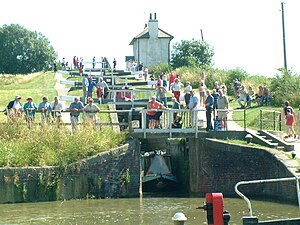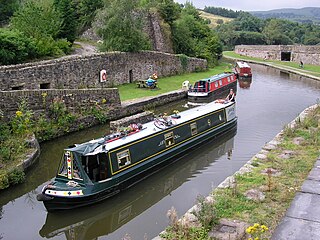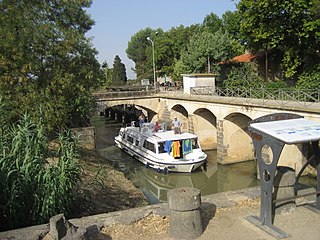
A gongoozler is a person who enjoys watching activity on the canals of the United Kingdom. The term is also used more generally to describe those who harbour an interest in canals and canal life, but do not actively participate.

A gongoozler is a person who enjoys watching activity on the canals of the United Kingdom. The term is also used more generally to describe those who harbour an interest in canals and canal life, but do not actively participate.
Gongoozler may have been canal workers' slang for an observer standing apparently idle on the towpath. According to The Times, the term has also previously been used to describe "someone who hung around bridges to laugh at the inept efforts of less experienced barge folk as they struggled to pass through locks". Though it was used derisively in the past, today the term is regularly used, perhaps with a little irony, by barge communities and clubs to describe themselves and their hobby. [1] [2]
Barge communities and clubs have these days adopted the term — in an ironic sense — to describe themselves.
The word may have arisen from words in Lincolnshire dialect: gawn and gooze, both meaning to stare or gape. [3] It might be presumed that such an expression would date from the nineteenth century, when canals were at their peak, but the word is only recorded from the end of that century or the early twentieth. It was given wider use by L. T. C. Rolt, who used it in his book about canal life, Narrow Boat , in 1944. [4] A gawn is also a small ship of lading, such as a working-narrowboat. [5]
The term gongoozler may also be used in any circumstance in which people are spectating without contributing to either the content or interest of an event. According to the team behind BBC Radio 4 programme Word of Mouth, the word can mean "a person who likes to mindlessly stare (at anything)". [6]
Gongoozling, much like trainspotting, is a hobby that can extend to all aspects of canals.
The collection or creation of canal-related artwork is a common pastime amongst gongoozlers. This includes paintings, postcards and photographs.
Canal locks often attract spectators, including gongoozlers, because the operation of manual canal locks is a complex affair, with a number of opportunities for mistakes to be made. Some observers have been known to heckle or harass the boat crews, whilst others carry a lock windlass and actively wish to help boat crews with their passage, by opening the paddles, or helping push open the heavy balance beams on the gates.
Whilst trainspotting is commonly associated with identifying engine makes, it is rare for Gongoozlers to do likewise. However an interest can occur for the history of a section of canal, or the operation of locks and alternative devices such as inclined planes, water slopes, and boat lifts with types like the Anderton boat lift, the Falkirk Wheel and the Strépy-Thieu boat lift.
The eight locks of Fonserannes on the Canal du Midi in Southern France attract so many gongoozlers that they have become the third most popular tourist attraction in Languedoc. [7]
In the UK, Foxton Locks (pictured above) in Leicestershire and the Caen Hill flight on the edge of Devizes, Wiltshire are popular locations for gongoozlers to gather.

A barge is typically a flat-bottomed vessel which does not have its own means of mechanical propulsion. Original use was on inland waterways, while modern use is on both inland and marine water environments. The first modern barges were pulled by tugs, but on inland waterways, most are pushed by pusher boats, or other vessels. The term barge has a rich history, and therefore there are many types of barges.

Canals or artificial waterways are waterways or engineered channels built for drainage management or for conveyancing water transport vehicles. They carry free, calm surface flow under atmospheric pressure, and can be thought of as artificial rivers.

The Grand Union Canal in England is part of the British canal system. It is the principal navigable waterway between London and the Midlands. Starting in London, one arm runs to Leicester and another ends in Birmingham, with the latter stretching for 137 miles (220 km) with 166 locks from London. The Birmingham line has a number of short branches to places including Slough, Aylesbury, Wendover, and Northampton. The Leicester line has two short arms of its own, to Market Harborough and Welford.

A narrowboat is a particular type of canal boat, built to fit the narrow locks of the United Kingdom. The UK's canal system provided a nationwide transport network during the Industrial Revolution, but with the advent of the railways, commercial canal traffic gradually diminished and the last regular long-distance transportation of goods by canal had virtually disappeared by 1970. However, some commercial traffic continued. From the 1970s onward narrowboats were gradually being converted into permanent residences or as holiday lettings. Currently, about 8,580 narrowboats are registered as 'permanent homes' on Britain's waterway system and represent a growing alternative community living on semi-permanent moorings or continuously cruising.

A lock is a device used for raising and lowering boats, ships and other watercraft between stretches of water of different levels on river and canal waterways. The distinguishing feature of a lock is a fixed chamber in which the water level can be varied; whereas in a caisson lock, a boat lift, or on a canal inclined plane, it is the chamber itself that rises and falls.

The Canal du Midi is a 240 km (150 mi) long canal in Southern France. Originally named the Canal Royal en Languedoc and renamed by French revolutionaries to Canal du Midi in 1789, the canal is considered one of the greatest construction works of the 17th century.

The canal network of the United Kingdom played a vital role in the Industrial Revolution. The UK was the first country to develop a nationwide canal network which, at its peak, expanded to nearly 4,000 miles in length. The canals allowed raw materials to be transported to a place of manufacture, and finished goods to be transported to consumers, more quickly and cheaply than by a land based route. The canal network was extensive and included feats of civil engineering such as the Anderton Boat Lift, the Manchester Ship Canal, the Worsley Navigable Levels and the Pontcysyllte Aqueduct.

The Llangollen Canal is a navigable canal crossing the border between England and Wales. The waterway links Llangollen in Denbighshire, north Wales, with Hurleston in south Cheshire, via the town of Ellesmere, Shropshire. The name, which was coined in the 1980s, is a modern designation for parts of the historic Ellesmere Canal and the Llangollen navigable feeder, both of which became part of the Shropshire Union Canals in 1846.

A railfan, train fan, rail buff or train buff, railway enthusiast, railway buff, trainspotter or ferroequinologist is a person who is recreationally interested in trains and rail transport systems.
Lionel Thomas Caswall Rolt was a prolific English writer and the biographer of major civil engineering figures, including Isambard Kingdom Brunel and Thomas Telford. He is also regarded as one of the pioneers of the leisure cruising industry on Britain's inland waterways, and was an enthusiast for vintage cars and heritage railways. He played a pioneering role in both the canal and railway preservation movements.

Bingley Five-Rise Locks is a staircase lock on the Leeds and Liverpool Canal at Bingley. As the name implies, a boat passing through the lock is lifted or lowered in five stages.

The canals of the United Kingdom are a major part of the network of inland waterways in the United Kingdom. They have a varied history, from use for irrigation and transport, through becoming the focus of the Industrial Revolution, to today's role of recreational boating. Despite a period of abandonment, today the canal system in the United Kingdom is again increasing in use, with abandoned and derelict canals being reopened, and the construction of some new routes. Canals in England and Wales are maintained by navigation authorities. The biggest navigation authorities are the Canal & River Trust and the Environment Agency, but other canals are managed by companies, local authorities or charitable trusts.

The Montech water slope is a type of canal inclined plane built on the Canal de Garonne, in the commune of Montech, Tarn-et-Garonne, Southwest France. It is managed by the publicly owned Voies navigables de France and by-passes a series of five locks. The slope is used for larger vessels up to 40 metres in length, while smaller boats continue to use the locks.

A summit-level canal, sometimes called a "watershed canal" or just "summit Canal", is an artificial waterway connecting two separate river valleys. The term refers to a canal that rises to cross a summit then falls down the other side.

The South Pennine Ring is an English canal ring which crosses the Pennines between Manchester and Huddersfield. It covers parts of five canals, and includes passage through the longest canal tunnel in Britain. It has only been possible to cruise it since 2002, when restoration of the Huddersfield Narrow Canal provided the return route across the Pennines.

There are 91 working locks on the Canal du Midi along its 240-kilometre (150 mi) course from the Bassin du Thau on the Mediterranean coast to the junction with the Canal lateral a la Garonne in Toulouse. There are a further 13 locks on the 37-kilometre (23 mi) La Nouvelle branch which runs through Narbonne to the Mediterranean at Port-la-Nouvelle. The locks are all under the management of the French navigation authority, Voies navigables de France.

The Fonseranes Water Slope is a disused inclined plane on the Canal du Midi parallel to the Fonseranes Lock. It has a rise of 13.6 m (45 ft) and a slope of 5°.

Ouvrages du Libron is a structure like no other on the Canal du Midi. It allows the Libron River, near Agde in south-west France, to traverse the Canal du Midi. At the point of intersection, the Libron is more or less at the same level as the Canal du Midi so a traditional aqueduct was not an option. The problem was further exacerbated by the Libron's propensity to flash flood up to twenty times a year. The problem was originally solved by the building of a pontoon aqueduct known as the Libron Raft which utilised a flush-decked barge to protect the canal channel in times of flooding. However, this was replaced by the present structure in 1855.

Roses and Castles is a style of art used to decorate narrowboats and their fittings. As well as depicting roses and/or castles, the designs often include other flowers and landscapes.

A widebeam is a canal boat built in the style of a British narrowboat but with a beam of 2.16 metres or greater.